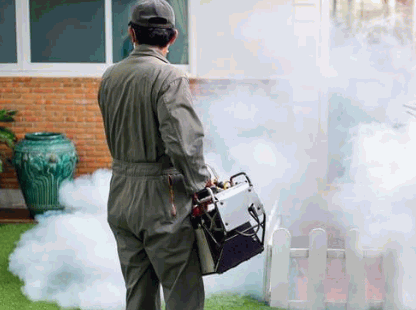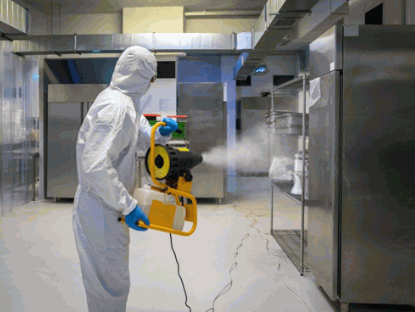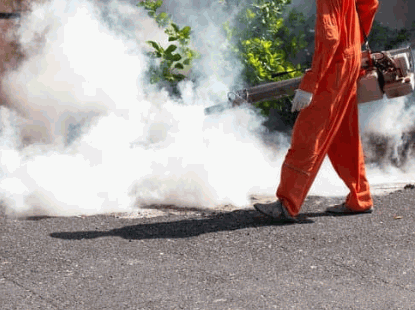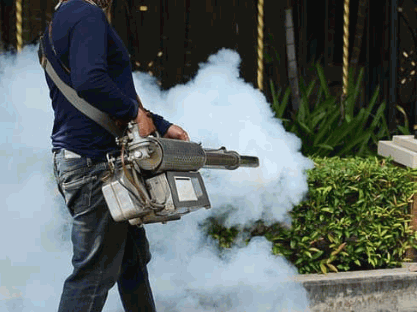Here at The Sparkle Gang, we love creating posts that help our customers better understand the cleaning techniques we use.
One of the questions we see most often is 'What is fogging?'.
To help clear things up today, we'll talk more about this cleaning method, what it is, what it does, and why you might want to use it, so you can decide if fogging is an effective method for you.
Ready to find out more? Then join us below.
Fogging is a method that cleaning companies like ours sometimes use to help with disinfecting surfaces. It's important to note that the World Health Organisation advises that we should only use the fogging method on hard surfaces and NEVER on the skin because the chemicals used can cause irritation.
That's why anybody using a fogging machine for cleaning purposes must wear the proper protective clothing to make sure they are completely safe. The human body will not take kindly to contamination from fogging chemicals if exposed.
With that said, fogging is completely safe to use when disinfecting a surface. There are no health risks associated with it, and any residue left behind after cleaning will not be harmful.
Those who use fogging to help with the disinfection and decontamination of an environment will know that there are three main types:
The different types of fogging are selected based on the surfaces that are being cleaned. Wet fogging may not be suitable for certain surface types because they may be sensitive to moisture. In this case, dry or ultra-dry fogging would be selected instead.
The cleaning company carrying out the cleaning will choose fogging methods to suit the surface they are working with.

In order to help you understand why people use fogging, we thought it would be a good idea to look a little closer at the fogging machine and how the method works, so you can understand where it may be helpful.
The first thing any professional fog cleaner will do is select the chemicals for the spray. Typically, this will be hydrogen peroxide, but chlorine dioxide works too, as does a range of other chemicals.
The important thing is that the cleaner selects the disinfectants that will be most effective in the environments they are working.
Once the chemicals have been selected, the cleaner will set up the fogging machine accordingly.
Whether they will be using wet, dry, or ultra-dry fog will be important here. Yes, their aim is to disinfect in an effective way, but making sure the surfaces that are being sprayed with disinfectant remain intact is just as important.
As soon as the machine is set up correctly, the cleaner will make sure the area is clear, ensure their protective gear and equipment are all in place, and then they'll get started on the spraying.
The key to a successful spray is using a very fine mist. This mist settles on the surfaces that are being cleaned and help in a number of ways:
This fine mist/fog can be applied to a range of surfaces, too; walls, floors, food contact surfaces - even electrical appliances (so long as a dry or ultra-dry method is used).
With the mist the machine helps to create, you can reach areas of the environment that are commonly prone to contamination to help disinfect it. Better yet, the fog will clean the entire room, even those hard-to-reach areas you might not think of.
Fogging is an excellent cleaning method that takes care of everything from disinfecting surfaces to making the air in the atmosphere safer to breathe thanks to its ability to kill pathogens. It is the best cleaning process to use if you need to disinfect both large areas and smaller areas fast.
Check out: Ultimate Home Remedies For Slippery Floors
We can use fogging in a number of environments and settings. Below are just some of the places where it is an especially suitable cleaning process to use:
It's worth noting that one of the most popular places to use fogging is the food industry. Restaurants, food preparation areas, and even mobile units like food trucks and stalls can all benefit from fogging.
The fog droplets are all 100% safe and won't leave behind traces of the disinfectant used in the spray anywhere in the room, making it completely ok to use in a space where food is made and served.
Check out: Ultimate Pub Cleaning Checklist

Healthcare settings are an obvious space for fogging to be carried out. Care homes, hospitals - basically anywhere that has a risk of virus or contamination will require disinfection and fogging is great for that.
In large areas like hospitals, fogging is ideal because one litre of water with just one cleaning tablet dissolved in it will create enough fog to disinfect a large space quickly and easily.
This was ideal during the COVID-19 virus, for example, which needed wards to be covered in a disinfectant quickly to reduce the risk to other patients.
Although the two examples above are obvious, you can carry out fogging in almost any area. Of course, you need the right equipment and training (so it must always be carried out by pros who know the right ratio of disinfectant to water to carry out cleaning and disinfection safely), but if you have a space that needs to be cleaned deeply, then you can use this fog technique. We also offer one-off deep cleaning as a service.
That means houses, offices, business premises, you name it - if you need disinfectant to be applied to an area quickly and effectively, then fogging is a great technique.
Absolutely.
Because fogging uses chemicals, many people assume it isn't safe. This couldn't be further from the truth.
Only a small amount of chemicals is used. Enough to kill bacteria and disinfect an area, but NEVER enough to cause harm to humans.
That's why it's safe to use in areas where food is prepared.

Yes. The fog is made up of disinfectant that is highly efficient at killing a range of viruses and bacteria.
In fact, during the COVID-19 pandemic, fogging became a more popular cleaning system than ever before, thanks to its effectiveness.
It depends on the size of the area that is being cleaned. It's worth discussing this with the cleaning company you hire before they start work so you can know how long the premises will need to be vacated.
There is a range of benefits to fogging, but below are just a few in case you're still not sure about it as a cleaning technique:

Fog and mist created by fogging machines will reach places you hadn't even thought of - cleaning everything as it goes.
You won't find a more effective cleaning technique for hard surfaces that need disinfecting.
Not only will it leave everything clean, it leaves everything safe, too. That means any harmful bacteria are killed, and your surfaces are safe to use once more.
Fogging is one of the most effective cleaning techniques around, so if you have a space that needs cleaning thoroughly and quickly, then fogging might just be the perfect system for you.
Get in touch with The Sparkle Gang today if you think this cleaning technique is something that could benefit you. We'd love to help you get your home/business back to the clean, sanitised space it needs to be!
Check out: Remove Efflorescence From Brick With Vinegar